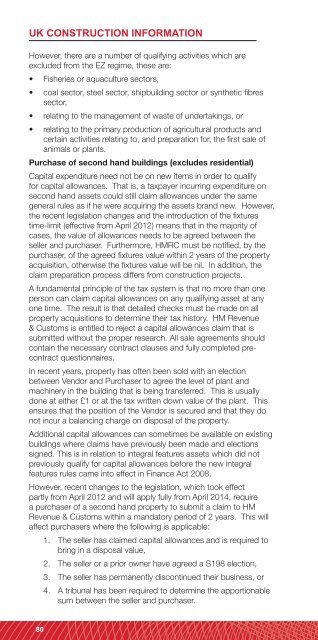RLB_UK_Riders_Digest_2013
RLB_UK_Riders_Digest_2013
RLB_UK_Riders_Digest_2013
Create successful ePaper yourself
Turn your PDF publications into a flip-book with our unique Google optimized e-Paper software.
<strong>UK</strong> CONSTRUCTION INFORMATION<br />
However, there are a number of qualifying activities which are<br />
excluded from the EZ regime, these are:<br />
<br />
<br />
sector,<br />
<br />
<br />
certain activities relating to, and preparation for, the first sale of<br />
animals or plants.<br />
Purchase of second hand buildings (excludes residential)<br />
Capital expenditure need not be on new items in order to qualify<br />
for capital allowances. That is, a taxpayer incurring expenditure on<br />
second hand assets could still claim allowances under the same<br />
general rules as if he were acquiring the assets brand new. However,<br />
the recent legislation changes and the introduction of the fixtures<br />
time-limit (effective from April 2012) means that in the majority of<br />
cases, the value of allowances needs to be agreed between the<br />
seller and purchaser. Furthermore, HMRC must be notified, by the<br />
purchaser, of the agreed fixtures value within 2 years of the property<br />
acquisition, otherwise the fixtures value will be nil. In addition, the<br />
claim preparation process differs from construction projects.<br />
A fundamental principle of the tax system is that no more than one<br />
person can claim capital allowances on any qualifying asset at any<br />
one time. The result is that detailed checks must be made on all<br />
property acquisitions to determine their tax history. HM Revenue<br />
& Customs is entitled to reject a capital allowances claim that is<br />
submitted without the proper research. All sale agreements should<br />
contain the necessary contract clauses and fully completed precontract<br />
questionnaires.<br />
In recent years, property has often been sold with an election<br />
between Vendor and Purchaser to agree the level of plant and<br />
machinery in the building that is being transferred. This is usually<br />
done at either £1 or at the tax written down value of the plant. This<br />
ensures that the position of the Vendor is secured and that they do<br />
not incur a balancing charge on disposal of the property.<br />
Additional capital allowances can sometimes be available on existing<br />
buildings where claims have previously been made and elections<br />
signed. This is in relation to integral features assets which did not<br />
previously qualify for capital allowances before the new integral<br />
features rules came into effect in Finance Act 2008.<br />
However, recent changes to the legislation, which took effect<br />
partly from April 2012 and will apply fully from April 2014, require<br />
a purchaser of a second hand property to submit a claim to HM<br />
Revenue & Customs within a mandatory period of 2 years. This will<br />
affect purchasers where the following is applicable:<br />
1. The seller has claimed capital allowances and is required to<br />
bring in a disposal value,<br />
2. The seller or a prior owner have agreed a S198 election,<br />
3. The seller has permanently discontinued their business, or<br />
4. A tribunal has been required to determine the apportionable<br />
sum between the seller and purchaser.<br />
80






